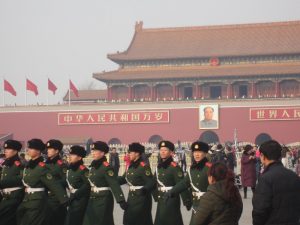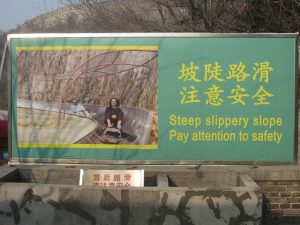Maos, of one sort or another, bookended my time in Japan and China. (Sorry; this post is a bit long, as It covers two ports.)
In Japan, I was the “faculty liaison” for a trip of faculty, staff, and students to Mount Kōya, the headquarters of Shingon Buddhism and the location of the mausoleum of Kūkai (774-835), better known as Kōbō Daishi, who founded the sect. Kūkai was born as Saeki no Mao. Shingon is an esoteric form of Buddhism developed from teachings of Huiguo in China, with whom Kūkai studied in the early 9th century in the Tang Dynasty capital of Chang’an (present-day Xi’an). My limited knowledge of Buddhism did not earn me the right to liaise the trip; rather, my abilities in Japanese (even though they also have their limitations!) were sought for translation. We had a fascinating meditation session with Shingon monk Tomita-san (Mr. Tomita), practicing a-soku-kan (「あ」息観) meditation, which means, literally, “watching the breathing of the syllable ‘a,’” “a” being the first syllable in the Sanskrit alphabet. We exhaled “a” together 3 times (deep inhales and exhales), then gradually reduced our vocal exhalations until there was an extended silence.
Thereafter, we had Q and A with Tomita-san. This was most intriguing: Tomita-san described the objective of Shingon not as attempting to extinguish desire by following a path of moderation (which is taught as the primary objective in Theravada Buddhism, for example), but as attempting to meld oneself with the universe, recognizing that the Buddha, all other beings and you yourself are all essentially the same. This “awakening” is achieved through the practice of compassion, a practice that does conform to other sectarian teachings. But the acceptance that desire is a human frailty that cannot be overcome as a core teaching of Shingon has reshaped my understanding of esoteric Buddhism in Japan. For the newcomers to Japan on our trip, their experience of the Japanese tradition of hospitality (kantai) and the deliciousness of Japanese baths, especially in the snowy mountains, endeared Japan to them forever.
China’s Mao was much more complicated. His portrait still reigns over Tiananmen Square (and is replaced every year by a new painting, to retain a fresh appearance, physically and philosophically, I suppose). It also graced living rooms we visited, hotel lobbies, and much Chinese currency. His perpetration of the heinous Cultural Revolution is seemingly overlooked, or conveniently forgotten, in contemporary rhetoric. There are perspectives from that period, of course, that do not conform to American propaganda. For example, we visited a hutong neighborhood (one of the traditional areas of narrow alleyways connecting family courtyards, some of which were infamously razed to make way for some of the 2008 Beijing Olympic venues); the owner of a family restaurant housed therein, who had moved to Beijing from the countryside during that period, had a different story. When the communist party redistributed the “bourgeois” properties collected from those sent for re-education, her family received a courtyard with living facilities for one family. They currently pay $600/year to live there, even though they have prosperous restaurant on the property. This system will soon be abolished (their son will have to relinquish the property to the state) so they have bought a condo on the outskirts of town. They also take two international trips a year; their favorite spot is Scandinavia. So Mao is revered in their home.
On the other hand, our guide in Beijing, Duan Fang Ming (pictured here with the owner of the hutong restaurant, whose name I did not catch), has had a mixed relationship with the Communist Party. He was a student at Beijing University and participated in the Tiananmen demonstrations (which he would not discuss in public by the way, only on the tour bus). Because of his involvement, he was sent for six months of “re-education” and blocked from service in the Foreign Ministry, which had been his goal, and an achievable one, as he had been at the top of his class. But he has made his way: he owns a duplex on the outskirts of town and he and his wife make many trips abroad (his wife works for an adoption agency). Wearing a mask to guard against pollution and suffering a lot of shouting, pushing and shoving, not to mention hearing many stories of loss and persecution, I found China exasperating, but also in many ways alluring—there are many people putting the myth of Mao to work for them. China has Mao, but we have Michelle, who also serves the people of China–as a model for how to gracefully ride the toboggan down from the top of the Great Wall.






February 14, 2017 at 8:30 am
Hi Julie, we are wrapping up our trip in Japan – only two more days in Kyoto. Alan and I remember with great pleasure our time in Koyasan. We spent one night in a monastery and had an OMG in the morning meditation class; we also walked through the forested cemetery to the temple/shrine and we both delighted in the shojin ryori meals.
Tomorrow we go to Uji and the day after, Ohara in the north.
When you and Blake get back, we should get together to compare stories. Tell Blake that we are curious to hear his thoughts and see how this experience matured him.
Ciao
Antonella and Alan